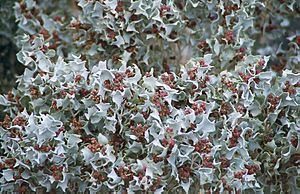Desert holly facts for kids
Quick facts for kids Desert holly |
|
|---|---|
 |
|
| Scientific classification | |
| Genus: |
Atriplex
|
| Species: |
hymenelytra
|
The desert holly (scientific name: Atriplex hymenelytra) is a cool-looking silvery-gray shrub. It belongs to the plant family Amaranthaceae. You can find it growing naturally in the hot deserts of the southwestern United States. This plant is super tough! It's the best at handling dry conditions among all the saltbush plants in North America. It can even survive in the hottest and driest parts of Death Valley and stays active most of the year.
Its common name, "desert holly," comes from its leaves. They look a bit like the leaves of a traditional holly plant, but they are not related at all. The desert holly has jagged-edged leaves and small reddish fruits. These features make it look a little like the European holly, even though they are different plants.
Contents
Where Desert Holly Grows
Desert holly loves to grow in places with alkaline soil. You can often find it in dry desert riverbeds or in areas with creosote bush scrub. It lives in the Mojave Desert and the Sonoran Desert, stretching all the way down to Baja California in Mexico.
In the Sonoran Desert, it grows in northwestern Mexico, western Arizona, southeastern California, and southwestern Utah. You can spot it at different heights, from about 250 feet (76 meters) to 3,900 feet (1,189 meters) above sea level.
This plant is incredibly hardy. If the soil is dry, it can survive temperatures as low as -10°F (-23°C). However, it won't survive if the ground freezes solid.
What Desert Holly Looks Like
How It Grows
Desert holly usually grows as a round, bushy plant. It can be anywhere from 8 to 48 inches (20 to 122 centimeters) tall. It's easy to spot because it's covered in unique, shiny silver-gray leaves. These leaves are twisted, oblong, and have many points.
If there's an extreme drought, the plant might drop its leaves. This is a clever way to save water, just like some trees lose their leaves in winter.
This plant can handle tough conditions. It grows well in soil that is alkaline, salty, or sandy. Its leaves collect salts, which helps the plant pull water from the soil. This is something many other plants can't do. The plant gets rid of extra salt by dropping its leaves. It can even live in water with up to 30 parts per million (ppm) of Boron. Most plants can only handle about 1-5 ppm.
Like other desert plants in the Atriplex family, desert holly has a special way to save water called C4 photosynthesis. It also has tiny bladders in its leaves. These bladders store salt, keeping it away from the plant's cells.
Roots, Stems, and Leaves
The leaves of the desert holly are oval to round, about 1/4 to 3/8 inches (0.6 to 1 centimeter) long. They are silvery-gray and have a whitish, reflective coating of tiny scales. They are shaped like twisted or wavy holly leaves with jagged edges. The silvery color comes from salts that gather on tiny hairs on the leaf surface. This silvery coating helps reflect sunlight, which reduces how much water the plant loses.
Flowers and Fruits
Desert holly blooms from January to April in the Sonoran Desert.
In their natural desert homes, desert holly plants are usually either male or female. This means one plant will have only male flowers, and another will have only female flowers. But if you move them to a cooler, wetter place, a single plant might grow both male and female flowers!
The female flowers are green.
After flowering, the plant produces green or red fruits. These fruits grow in tight bunches and are covered by two disc-shaped, leaf-like structures called bracts. These two bracteoles are pressed together around the fruit.
Human Uses
People once used dried and dyed desert holly plants as Christmas decorations. Luckily, these plants are not considered an endangered species in most places where they grow.
See also
 In Spanish: Atriplex hymenelytra para niños
In Spanish: Atriplex hymenelytra para niños

